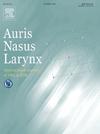Running pattern of the internal maxillary artery assessed using arterial-phase CT images in 434 sides in Japanese individuals
IF 1.5
4区 医学
Q2 OTORHINOLARYNGOLOGY
引用次数: 0
Abstract
Objective
The internal maxillary artery (IMA) follows two primary running patterns: lateral, where it traverses the superficial layer of the lateral pterygoid muscle, and medial, where it passes through the deep layer. The frequency of these patterns varies among populations, with the medial type reported in 6–18 % of Asians and 37–46 % of Caucasians. Ligation of the IMA, commonly performed during total or partial maxillectomy to reduce bleeding, is more challenging in the medial type due to its deeper anatomical position. Therefore, preoperative identification of its pattern is crucial. This study analyzed the IMA running pattern in Japanese individuals using arterial-phase CT and the diagnostic accuracy of standard contrast-enhanced CT.
Methods
We retrospectively analyzed 434 sides from 217 Japanese individuals who underwent arterial-phase CT. The IMA was classified as lateral or medial based on its relationship with the lateral pterygoid muscle. We evaluated whether the running pattern was influenced by anatomical side, gender, or the side of tumor involvement using Fisher’s exact test. In 213 patients, arterial-phase CT findings were compared with standard contrast-enhanced CT.
Results
The lateral and medial types were observed in 94 % (407 sides) and 6.2 % (27 sides), respectively. No significant differences were found between anatomical sides (p = 0.11), gender (p = 0.092), or tumor involvement (p = 0.57), though symmetry was significant (p = 0.003). Standard contrast-enhanced CT showed 97.4 % concordance with arterial-phase CT but misclassified 17 % of medial cases.
Conclusion
The lateral type was predominant in Japanese individuals. Preoperative assessment of the IMA using arterial-phase CT is recommended when standard CT is inconclusive. Accurate identification can improve surgical precision and reduce complications.
利用日本人434侧的动脉期CT图像评估上颌内动脉的运行模式
目的上颌内动脉(IMA)有两种主要的运行模式:外侧,它穿过外侧翼状肌的浅层,和内侧,它穿过深层。这些模式的频率因人群而异,据报道,6 - 18%的亚洲人和37 - 46%的高加索人患有中间型。IMA结扎通常在全部或部分上颌切除术中进行,以减少出血,由于内侧型的解剖位置较深,因此结扎更具挑战性。因此,术前识别其模式是至关重要的。本研究分析了日本人动脉期CT的IMA运行模式和标准增强CT的诊断准确性。方法回顾性分析217例日本患者的434侧动脉期CT。IMA根据其与外侧翼状肌的关系被分为外侧或内侧。我们使用Fisher精确检验评估奔跑模式是否受到解剖侧、性别或肿瘤受累侧的影响。213例患者的动脉期CT表现与标准增强CT相比较。结果外侧型和内侧型分别占94%(407侧)和6.2%(27侧)。解剖侧面(p = 0.11)、性别(p = 0.092)或肿瘤受累程度(p = 0.57)之间无显著差异,但对称性显著(p = 0.003)。标准对比增强CT显示97.4%与动脉期CT一致,但有17%的内侧病例分类错误。结论日本人以侧位型为主。当标准CT不确定时,建议术前使用动脉期CT对IMA进行评估。准确识别可提高手术精度,减少并发症。
本文章由计算机程序翻译,如有差异,请以英文原文为准。
求助全文
约1分钟内获得全文
求助全文
来源期刊

Auris Nasus Larynx
医学-耳鼻喉科学
CiteScore
3.40
自引率
5.90%
发文量
169
审稿时长
30 days
期刊介绍:
The international journal Auris Nasus Larynx provides the opportunity for rapid, carefully reviewed publications concerning the fundamental and clinical aspects of otorhinolaryngology and related fields. This includes otology, neurotology, bronchoesophagology, laryngology, rhinology, allergology, head and neck medicine and oncologic surgery, maxillofacial and plastic surgery, audiology, speech science.
Original papers, short communications and original case reports can be submitted. Reviews on recent developments are invited regularly and Letters to the Editor commenting on papers or any aspect of Auris Nasus Larynx are welcomed.
Founded in 1973 and previously published by the Society for Promotion of International Otorhinolaryngology, the journal is now the official English-language journal of the Oto-Rhino-Laryngological Society of Japan, Inc. The aim of its new international Editorial Board is to make Auris Nasus Larynx an international forum for high quality research and clinical sciences.
 求助内容:
求助内容: 应助结果提醒方式:
应助结果提醒方式:


